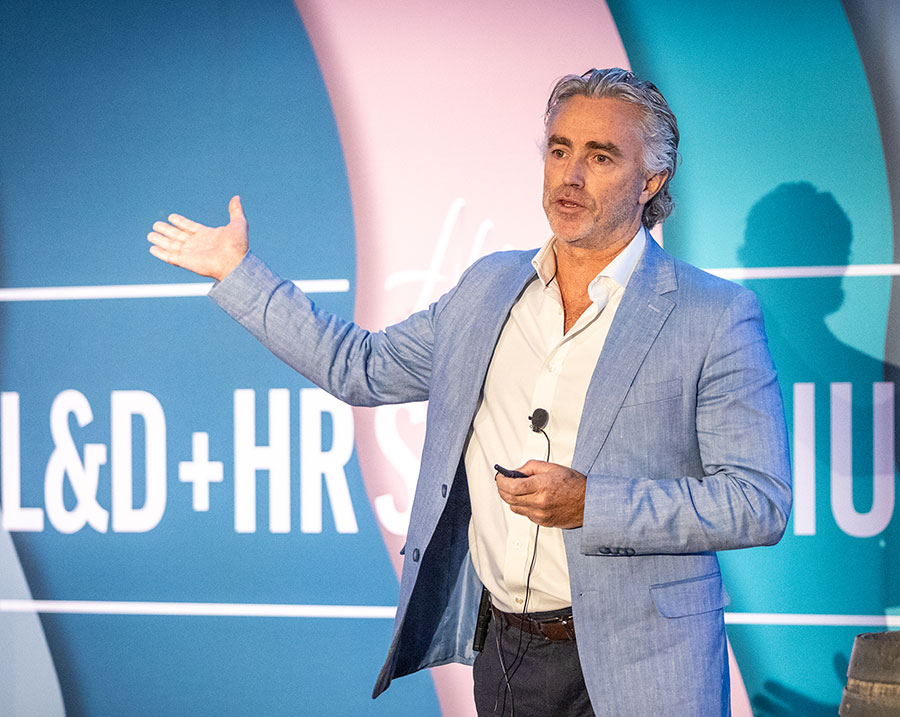Your Top questions answered
Damien Woods,
Chapter Lead, Learning & Growth, 7-Eleven



One of our keynote speakers at the L&D + HR Symposium, Damien Woods, Chapter Lead, Learning & Growth, 7-Eleven, presented his fantastic keynote on Agile Learning Culture at the L&D + HR Symposium 2023. Here he gives his responses to the top questions asked by the audience at the event.
What unexpected challenges did 7-Eleven encounter when implementing an agile learning culture, and how were they overcome?
A key challenge getting the right people in the role of Chapter Lead. It is a vital role, and requires someone passionate about developing others, not just interested in being a leader with a title. Helping chapter leads fully appreciate the core value in their role (developing their people) and then trying to help navigate the juggle between spending time delivering work and spending time on their people required effort. Some probably didn’t realise the heavy focus on developing people, and went after a role that wasn’t the right fit for them.
Are there any unique insights or surprises that emerged from this process that could inform other businesses attempting a similar transformation?
Agile ways of working are a fairly fundamental shift in how people experience work, and therefore there’s a steep change curve. Some people will opt out as they can’t cope with letting go of how they used to work. The change was significant, and doesn’t happen overnight, so a commitment to embedding over numerous years has been important. Measuring progress is vital, are we getting the intended outcomes, if not, why not and what do we need to do differently. So commitment, clear goals and regular measurement of progress (especially against external benchmarks where possible) are all important.
What are the key senior leadership capability skills or programs you have focused on driving in the new structure?
Leadership requires three major dimensions, leading an agile business, technical leadership (dependent on role) and then simply great leadership. Leadership is expected of everyone, and hierarchy should matter a lot less. Senior leadership need to move from being the gate keepers to the enablers, setting teams up to succeed and then getting out of the way and letting them get on with it. This can be a difficult transition, and when things get tough, there’s always the natural tendency to revert to “how we’ve always done things”, so a commitment to staying the journey is vital as well.
How did the learning technology ecosystem support your people embed the cultural transformation of agile?
Probably more broad than learning tech, but tech in general. We all use MS DevOps to capture all work, so there is visibility of the objectives and key results we are delivering as a business every quarter. Using DevOps means we can track real time the RAG status of all work. We use MS Teams like many others, but we’ve got very good at recording and publishing content from Teams sessions where it matters to other platforms (Sharepoint, LinkedIn Learning, Workjam). Also the ability to rapidly author digital content that connects with the 8000+ store members, along with a great channel to provide access, so we’ve used tools like Synthesia and Workjam to solve for this.
Did you say you had 13 learning people for 600 employees? That seems like a lot, can you elaborate?
We have 13 learning people, but its more like 9,000 colleagues we’re in service of rather than 600. We look after the whole business, the store network and the support office. That said, learning is considered really important in our ways of working so its an important skillset for our business. I’d add to that “learning people” cohort our Chapter Leads, of whom there are about 50. All of these play a vital role in how people learn and grow.
How are chapters aligned to the management structure of the business?
Structurally, our business is made up of Tribes (agile lingo for functions) and CoEs. Chapters live within the Tribe or CoE. So as Chapter Lead for Learning & Growth, I live in the People CoE. And our Food Innovation Chapter sits within the Product Tribe. Of the 13 Learning & Growth Chapter members who report to me, many are deployed in People CoE squads, but not all. I have 2 L&G Chapter members sitting in Food Squads and another in a Customer squad. We move people to the work that is the priority.
Where do you recommend folks go to upskill their agile L&D skills and ability?
I’ve recorded a few Podcasts with Michelle Ockers on Learning Uncut which should be helpful. I can also recommend a more recent one with Marc Howells from Astra Zenecca – https://learninguncut.global/podcast/128/
And here’s a link to one of mine – https://learninguncut.global/podcast/87/
What was the catalyst for the change from hierarchical to agile at 7-11?
We need to transform our business. We have real headwinds as we’re a petrol and convenience and EVs will take a very large so we need to plan for a world where our customers come to us for things other than petrol. To innovate faster and meet current and emerging customer needs, we decided agile ways of working would help accelerate the innovation lifecycle and helps us get products to customers faster.
The L&D + HR Symposium brings together 180+ enterprise L&D Leaders in the beautiful Hunter Valley